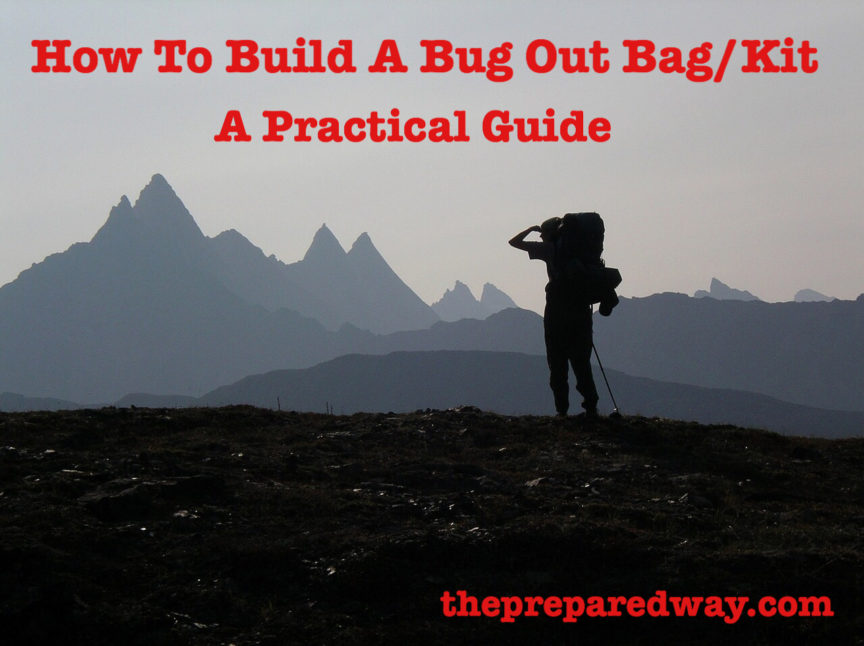You never know when a natural disaster or emergency will force you to abandon your home, so it’s important to have a some items ready for an evacuation. These kits often called a bug out bags, Bailout Bags or Go Bags. Even in the case of a house fire, a Bug Out Bag can be a life saver.
A Bug Out Kit is a multi-tier system that includes your:
- EDC Loadout
- Bug Out Bag
- Vehicle Bug Out Kit
EDC Loadout
An Every Day Carry Loadout Constitutes everything you carry with you on a daily basis. Your EDC Loadout should have everything you need to get from your current location to your Bug Out Bag and/or your home. This should include items you carry on you, plus an EDC bag, Bail Out Bag or Get Home Bag, whatever you want to call it. For a more in-depth look at everything, EDC check out this article I wrote; Practical EDC Essentials – What You Need And Why You Need It
The Bug Out Bag
The Bug Out Bag is the core of your bug out kit. It should have everything you need to get you to your bug out location. As a rule of thumb, your Bug Out Bag should have enough supplies to last at least 72 hours, even if your bug out location is less than a days travel on foot. The main focus of a Bug Out Bag is to keep you alive and well while you get to somewhere safer.
When putting together Bug Out Bags for you and your family remember to tailor each bag to the person who it is intended for. Each person has their individual needs so I don’t recommend those premade 72-hour kits you can find in the big box stores. Plus the gear in those kits is usually low quality, something I wouldn’t want to trust my life with, but if you have no other option they are better than having nothing. If you are on a tight budget check out an article I wrote >>> Prepping On A Budget – How To Prepare For Tomorrow While Making Ends Meet Today
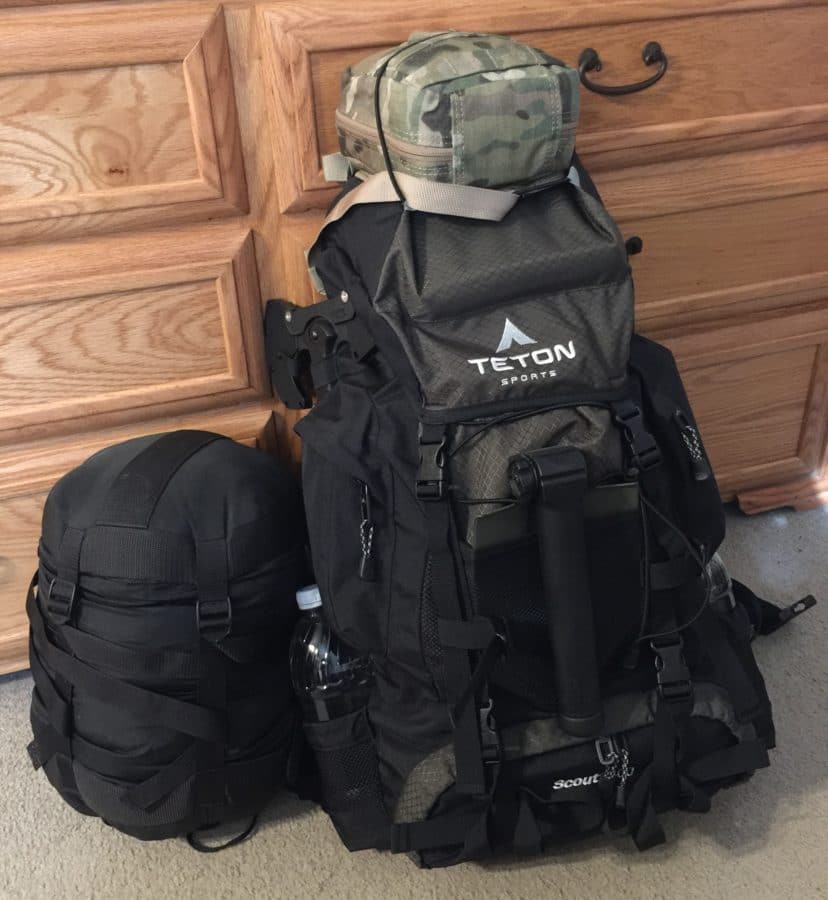
So where do you start? There are two different schools of thought on how to go about doing this. One is you get a backpack and you fill it with all of the items you need to take with you. The other method is to gather all of the items that you are going to need and then get a pack that will fit those items, this method is preferred but how you go about this is really personal preference.
I recommend for your first bag to get an inexpensive medium to large backpack or a smaller backpacking style pack that has an internal frame. Doing this will give you an idea of how much room your chosen gear will take up and how much it will weigh. The following is a list of
First Aid/Medical
First Aid and Medical may include:
- Trauma Kit
- Tourniquet
- Basic First Aid Kit
- Medications
- Sam splint
First aid and trauma skills are a valuable thing to have in daily life but in an emergency situation, they can be invaluable. Get training, just make sure it’s from a reputable source, online is okay but hands on

TRAUMA KIT: AKA a Ventilated Operator Kit (VOK) whereas the first aid kit is for minor cuts and scrapes, the VOK is for saving lives by stopping the 3 major causes of death, critical blood loss, obstructed airway, and tension pneumothorax. Most of these kits should include at least:
- Tourniquet
- QuickClot
- Compression bandage
- Gauze
- Nasopharyngeal (Nasal Airway 30FR)
- Surgilube
- Decompression Needle
- Nitrile Gloves
- Alcohol Prep Pads
- Duct Tape
- Medical Shears
NOTE: Even if you don’t have the necessary training to use all of the equipment in your trauma kit that doesn’t mean you shouldn’t carry it. Someone in your group or someone you befriend along the way, may have the knowledge and skills, and be able to put it to use saving your life or someone else’s.
TOURNIQUET: I know that I already listed this above but tourniquets save lives and having a few of them is good insurance. Also, I know of cases where it has taken 2 tourniquets to stop the bleeding on legs. Another positive is that a properly setup tourniquet allows for easy self-aid.
FIRST AID KIT: Everyone needs a basic first aid kit. These are more for minor, non-life threatening injuries. For a Bug Out Bag, this kit should be lightweight with the basics. You can build your own but it is often easier to buy a premade kit and add your own personal extras. One thing that I recommend adding is moleskin for preventing and treating blisters.
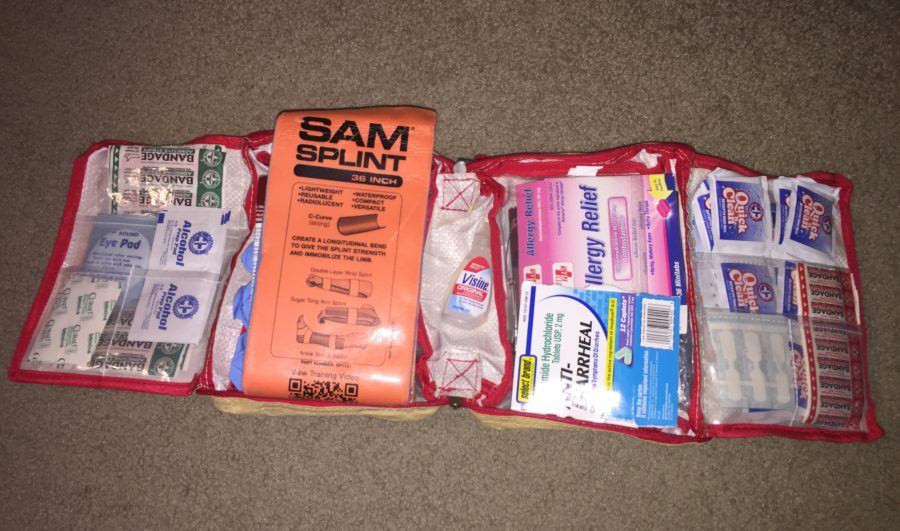
MEDICATIONS: There are a few generic medications that I would strongly recommend to keep your bug out
SAM SPLINT: The SAM Splint is a lightweight versatile splint design that allows the user to cut, mold, and shape the splint for a custom fit. When bugging out even an injured wrist or arm could bring your travels to a grinding stop. With the SAM Splint, you will be able to stabilize those injuries and keep moving.
Security/Protection
Being from the United States where firearms and knives are common self-defense tools I tend to lean toward these options but I also believe in having a wide range of skills and tools at my disposal. Ever heard the saying, If all you have is a hammer, everything looks like a nail. You can become trapped in the same mindset if you focus too much on one skill or tool when it comes to self-defense. I am a firm believer in having well-rounded self-defense skills.
Possessing, carrying, and using a firearm and/or other self-defense tools may or may not be legal in your state or country. Be sure to follow all laws that apply to your location. Then again, if there is no rule of law, use common sense and remember that at some point the rule of law will be re-established and you can and will most likely be held accountable for your
MARTIAL ARTS: Everyone should have some hand to hand self-defense skills. You don’t need to be a black belt just proficient at the basics.
FIREARMS: If you ask 100 people what the best bug out
I not saying don’t have a long gun, maybe a broken down Ruger 10/22 Takedown, AR or an AK with a folding stock stored in a pack or bag but remember these will add a substantial amount of weight to your system. Having a long gun will aid self-defense and in hunting for small game if your bug out plan has you traveling over such a distance that carrying all of the food you need to get there is not possible.
KNIVES: Knives have multiple uses during a bug out situation but for self-defense, I include a fighting folder in my EDC gear. A fighting folder has certain features, usually including a pocket clip and a larger one hand opening blade. As with firearms get training.
NONLETHAL: Nonlethal includes pepper spray, stun-guns, and tasers. Of the three pepper spray is the most commonly available and can be somewhat effective. Just know that when you spray that stuff, you will most likely get some in your eyes too. My favorite form of this is Bear Spray.
Bear Spray has two advantages over standard pepper spray. The first is distance, bear spray has a much further effective range and secondly, it has more volume. Also, if it can deter a bear it can deter a person.
Water
Water is one of those things that you can’t go too long without and still be able to physically function at a reasonable level of performance. Depending on the weather conditions and activity level, the average person needs about 2 liters or a 1/2 gallon of water per day. There are 2 parts to dealing with water, how to carry it and how to make it safe to drink. Water is heavy, try over 8 pounds per gallon, this makes carrying all your water for a multi-day bug out a terrible idea. The only exception would be if you are in a desert region where resupply will be impossible.
How are you going to make the water that you find drinkable? One thing I strongly recommend doing with all the water you collect is to prefilter it with a rag or bandana. This will extend the life of your filters by removing larger particles and debris. There are 3 methods that you might use during a bug out situation. The fastest and most convenient is to use a water bottle with a built-in filter system. One thing to keep in mind is that you should use only one of your containers for contaminated water to prevent cross-contamination.
The next option is to use an actual water filter system. Some of these systems use pumps, others use gravity or squeeze pressure to force water through the filter.
NOTE: Filters remove waterborne protozoa and bacteria, NOT viruses. Viruses are a lot smaller and require chemicals, UV light or boiling to eliminate them.
Another option is to use water purification tablets, due to taste this is my least favorite but it does work in a pinch. The last method is to boil your water for 10 minutes. This method requires that you have a fire source and a metal container to boil the water in and also takes the longest to prepare.
CANTEEN: I
COLLAPSIBLE WATER BOTTLE: Having a collapsible water bottle will allow you to easily store your water container when not in use and will also free up space in you pack as well.
WATER BLADDER: I have a love/hate relationship with my Camelbak water bladders. When you are using them they are great, they are very convenient and when combined with a pack that is made for them, it places the weight close to your back, the best location for 6 pounds of water. The hate part comes when you need to fill or clean the darn things. For bugging out you won’t be worrying about cleaning the bladder but you may have to fill it. Filling the bladder usually requires you to remove the entire thing from the pack, especially if it’s packed tightly.
WATER FILTER: I touched on this a little before but having a way to quickly filter water is a must. For a bug out
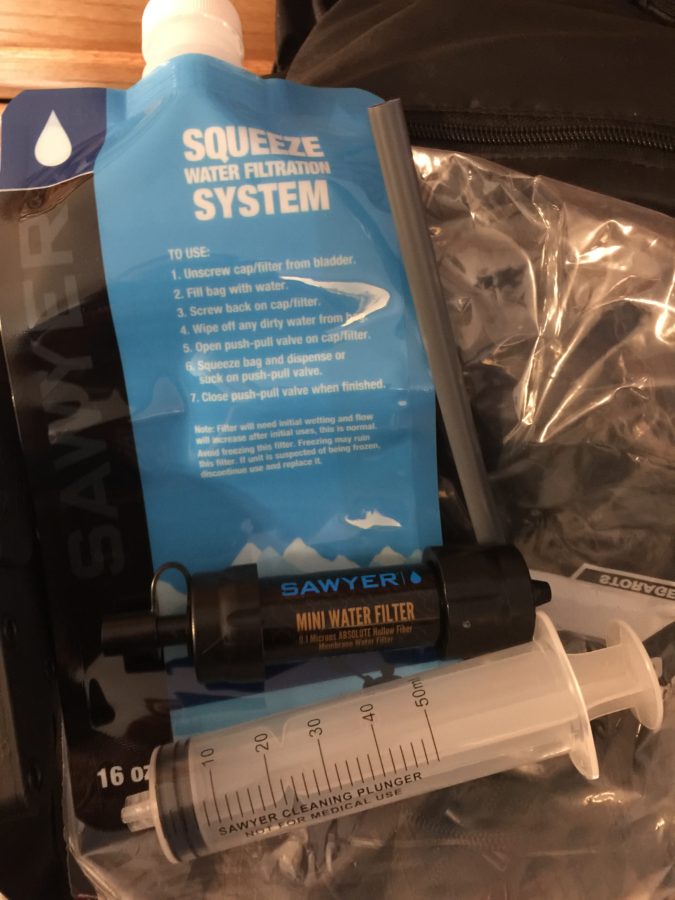
PURIFICATION TABLETS: These requires you place contaminated water into a container with a lid and it also takes time for the chemicals to do their job and makes the water taste, less than desirable but it’s safe to drink.
Fire Kit
Whether it’s for heat, boiling water or signaling for help, being able to start a fire could mean the difference between life and death. Starting a fire is a skill as old as humanity and yet most people today couldn’t start a fire without a lighter or matches. I’m not saying that while bugging out you need to make a Bow Drill and start your fires with that. What I am saying is that you should know how to build a Bow Drill and be able to make a fire on the off chance that your bug out bag and/or fire kits are lost.
Making fires using primitive bushcraft methods is labor intensive and time consuming when calories are at a premium you need a fire and you need it NOW. This is where your Fire Kit comes to the rescue. What is a Fire Kit, this is a small bag or pouch that has a collection of fire starting tools and supplies but can also be part of a small survival kit too.
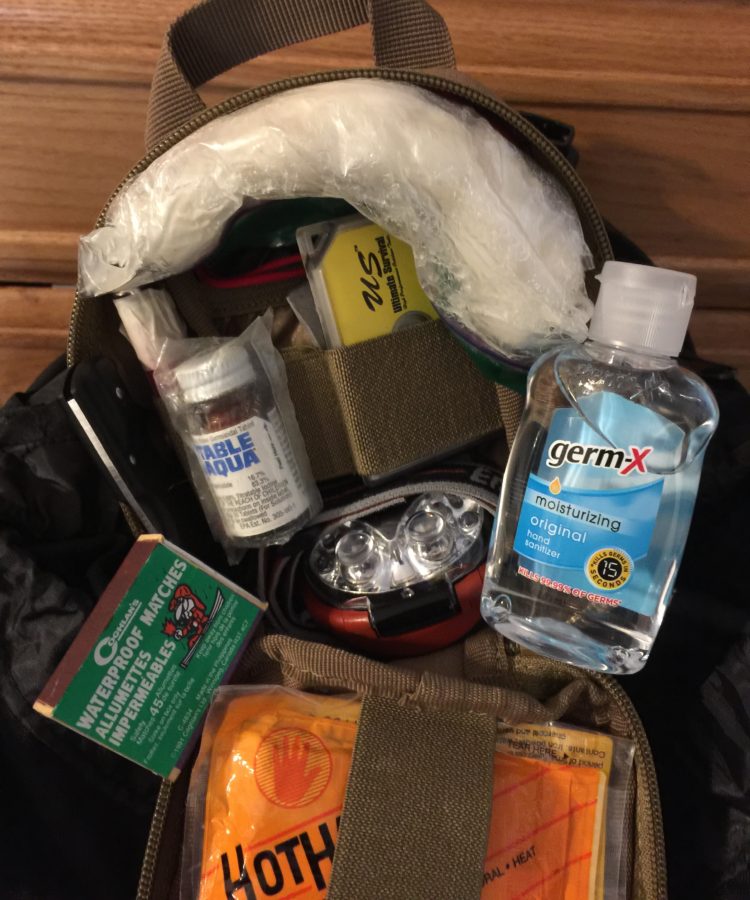
BIC LIGHTER: This is a no-brainer, if you do your part, a Bic lighter is going to get your fire going quickly. Just make sure that you keep that lighter dry because if it gets wet it’s not going to be much help.
WATERPROOF MATCHES: If that Bic lighter gets wet, you have an alternative, waterproof or stormproof matches. These things will work even when wet.
MAGNESIUM BLOCK WITH FLINT: This is another weatherproof option but it supplies both spark and fuel to get your tinder started.
COTTON BALLS & VASELINE: This is a great DIY option to help you get a fire going in adverse conditions.
HAND SANITIZER: This one is for those of you who are too lazy to mix up some cotton balls and Vaseline, it lights quickly but doesn’t burn as long.
Food
When it comes to packing food in your bug out bag there are a few things to consider before you start loading it up. The first question you need to answer is how many days of food do you need? Are you going to be packing a small camp stove to heat water? How much space and weight can you sacrifice?
MEAL REPLACEMENT BARS: Meal replacement bars or protein bars are a quick and easy solution when you are on the go and don’t have time to stop and eat an MRE.
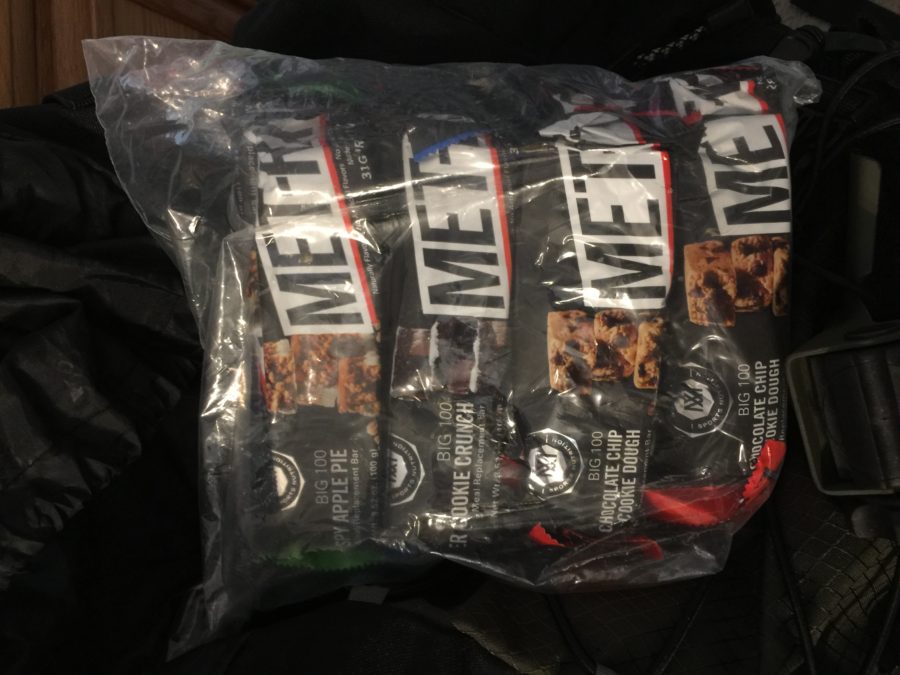
MRE’s: These are a meal in a bag, everything you need including utensils and many come with heaters too.
FREEZE DRIED: Prepackaged freeze-dried meals have some great advantages over all other food options, it’s very lightweight and has a long shelf life and is unaffected by the heat or cold. Because freeze-dried food has had all of the water removed it is really light and many have a shelf-life of 30 years. The only downside is that you need to add water to reconstitute the dehydrated food. Hot water is best but cold water can be used in a pinch.
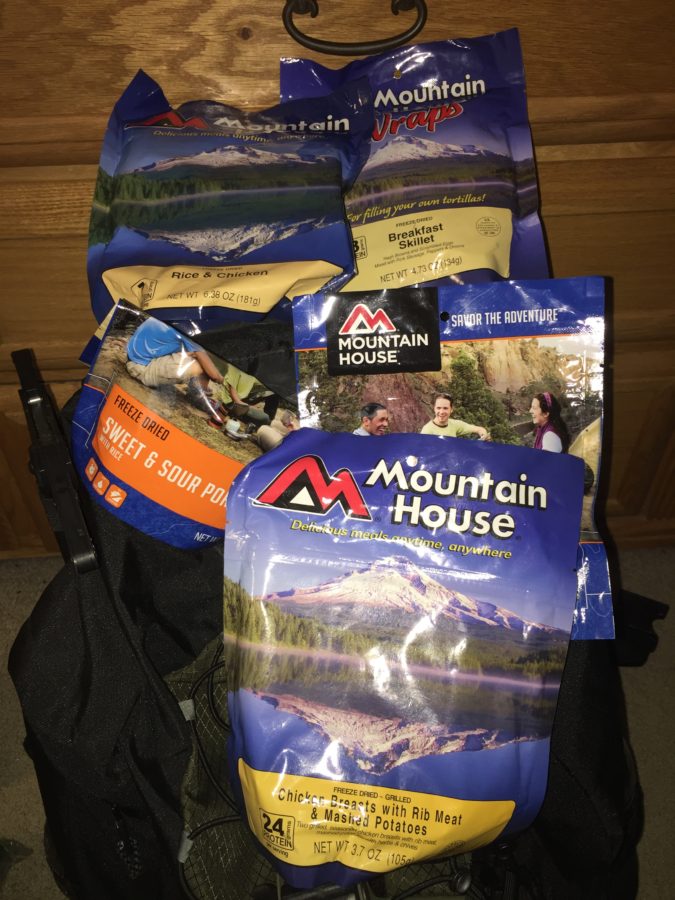
CANNED: You can use canned food but due to its weight it’s hard to justify when there are better options available.
UTENSILS: If you didn’t pack MRE’s you will need to remember something to eat with.
For a more in-depth look at the best foods for your bug out bag check out this article I wrote; Bug Out Bag Food: What’s The Best Food For Your Bag?
Shelter
My personal approach is to minimize weight and bulk and maximize versatility. That is why I prefer an old fashion G.I. poncho and a heavy duty mylar blanket/tarp. With clothing appropriate for your weather conditions this combo can be quite effective.
PONCHO: Using a G.I. style poncho can provide you with protection from the rain and other harsh weather and with the grommets you can make an impromptu tent.
EMERGENCY BLANKET: There are two types of emergency Mylar blankets. There are the ultra lightweight ones that are really made for one-time use and then there are heavy duty ones that have grommets and can double as a tarp or tent.
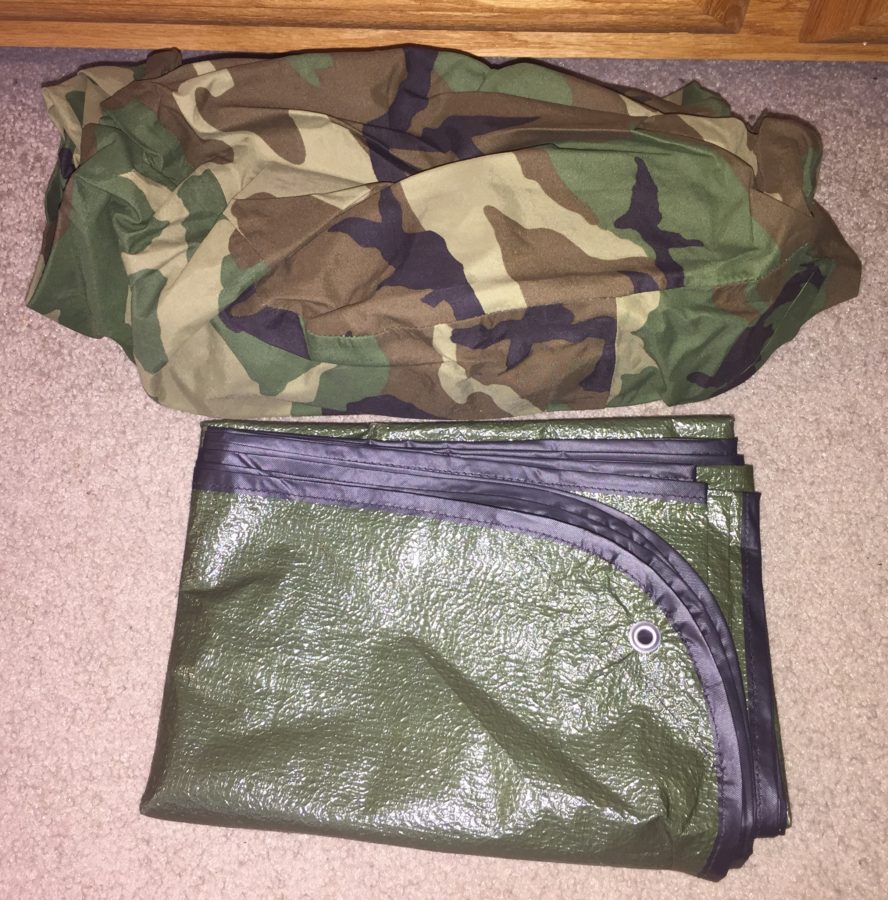
EXTREME COLD WEATHER: If you live in an area that sees extremely cold temperatures there are some extra things you should consider having. The first is a good sleeping bag with a windproof, waterproof cover. The second thing is a good ground pad to insulate and protect you from the ground. Lastly, a quality tent to offer another layer of protection from the elements.
Clothing
The clothing you should pack in your bug out bag will depend a lot on your location and the time of the year but as a baseline, you should have a complete change of clothes but stay away from 100% cotton.
SOCKS: Go with wool socks even in the summer. You can get lightweight wool blend sock that will provide warmth if you need it and moisture control to keep your feet dry and prevent blisters. I recommend having 2 extra pairs of socks.
FOOTWEAR: When it comes to footwear there are to schools of thought. There is always a debate between waterproof or breathable. Some will say that waterproof footwear will make your feet to sweat too much and cause blisters and other problems. Others will say they want to keep their feet dry as long as possible. I personally always used Gore-Tex lined boots and shoes, some are better than others at allowing moisture to escape but I also live in an area that sees rain and snow quite often.
Depending on your location you may want to rotate out lighter boots or shoe for some heavier boots during the fall and winter months. I find that in you combined the right Gore-Tex lined boots with heavy wool socks and you keep moving your feel will say plenty warm but when you stop moving you need to have a plan to keep them warm.
BASE LAYER: When you are looking at base layers you can go with wool or with synthetics. The idea of your base layer is to draw moisture away from your skin to keep you dry.
PANTS: Stay away from jeans as they are cotton. I prefer something with a poly/cotton or nylon/cotton blend. I like pants with cargo pockets to carry items in but try to stay away from military BDU’s to keep a low profile.
SHIRTS: These also will follow the trend go with moisture wicking materials like wool, synthetics or blends.
BANDANA/SHEMAGH: Whether it’s to keep the sun off you neck or to pre-filter your water, these have many uses.
WINTER DEPENDENT CLOTHING: I already covered footwear but there are some special considerations when you live in a region that can get really cold in the winter. I live in the upper Midwest where the in the winter the temperatures can get deep into the sub-zero range, add wind to that and it can become extremely dangerous. It is important that if you live in a region that sees these types of temperatures you should keep some midweight and hardshell outer layers with your bug out bag. Just remember to layer, so you can adjust for your activity level. Just make sure that you get out and do some hiking in these conditions, you will learn a lot.
Personal Protective Equipment (PPE)
There are many dangers out in the world that under normal conditions would warrant a trip to the clinic or ER but when there is a large or regional natural disaster emergency services may not be coming. When bugging out you may be many miles away from help if there is any. Have you ever heard the saying An ounce of prevention, is worth a pound of
EYE PROTECTION: You should have sunglasses to prevent eye strain or even snow blindness and to protect your eyes from debris. It wouldn’t be a bad idea to have a pair of clear safety glasses as well for moving at night.
GLOVES: When bugging out you may perform many different physical tasks that put your hands a greater risk of injury. Having some quality gloves to prevent possible cuts and punctures is a must. I prefer quality leather gloves because they are durable and flame resistant.
HAT/CAP: In warmer climates having a sun hat or cap to keep the sun off of your head and face. In colder weather having a good watch-cap can make a big difference in confort.
SUNSCREEN: Not only can sunscreen prevent sunburns it can reduce your chances of getting skin cancer too.
INSECT REPELLENT: An absolute must in the summer months to keep the bugs off and keeps you from getting eaten by mosquitos while trying to sleep.
N95 MASK: Keep from breathing in particulates from the air, whether is dust from buildings in the aftermath of an earthquake or ash from a volcanic eruption, you need to keep that stuff out of your lungs.
Navigation
It’s important to know where you are going and if you have to bug out you better have the necessary information about your route to get you there. Even if you are traveling by car a couple of wrong turns and you can easily get disoriented and lose your bearing.
MAPS: Don’t leave home without them. Having a collection of maps of your area or any areas you plan to travel is a must.
COMPASS: It’s easy to get turned around when in an unfamiliar area, turn off the lights and you can get turned around in your own backyard. Pairing a compass with your map and you should have no problem finding your way.
GPS: Having a GPS will make navigating to your bug out location a breeze, IF it works. One nice thing about a portable GPS is you can preprogram your bug out routes and you’re set. Just make sure you pair it with your backup map and compass for piece of mind.
Tools and Other Equipment
POWER BANK: If you don’t have one in your EDC Kit then having one in your Bug Out Bag is a must. Being able to charge your cell phone or other devices may be impossible while you are bugging out.
SOLAR CHARGER: Having a solar charger will make it possible to charge your power bank and other rechargeable devices.
FLASHLIGHT: Another item that you should already have in your EDC Kit but it’s not a bad idea to have a backup in your Bug Out Bag. I prefer something that has multiple power setting so you can conserve on batteries.
HEADLAMP: Whether your trying to setup camp or you are finishing the last leg of your bug out at night, having a headlamp so you can go hands free is a must.
BATTERIES: Don’t forget to pack extra batteries for your lights and any other electronics that you cannot charge with your power bank. Also, make sure to use Lithium batteries, as standard batteries WILL leak and destroy your devices.
MULTI-TOOL: You can’t pack a toolbox in your Bug Out Bag or can you? Having a good Multi-Tool in your Bug Out Bag can cover a lot of the things you may need to fix in a pinch.
FIXED BLADE KNIVES: If you need to process fish or game you will want something with a better blades than a multi-tool or pocket knife.
SILLCOCK KEY: This niffy little tool will allow you to turn on water valves that don’t have handles. If you live in the city this will be much more important than those of you live in more suburban and rural areas.
SHOVEL: Depending on your Bug Out Bag weight the extra weight of a small shovel may not be advisable but if you can, a small folding shovel can be very handy. With a shovel, you can do anything from dig a fire pit to bury your waste and much more.
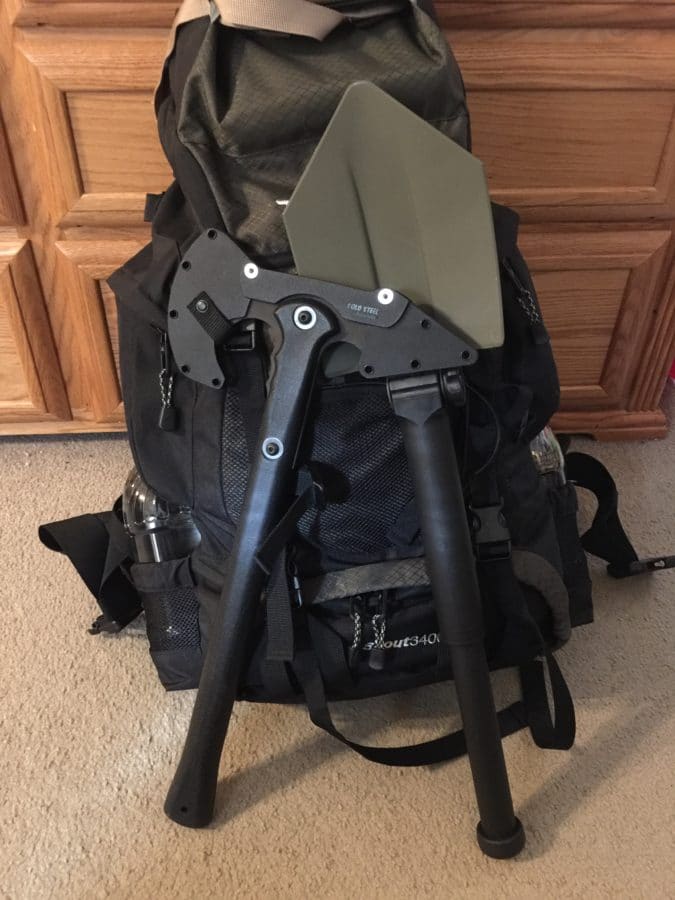
HATCHET: A hatchet or tomahawk has many uses, gathering and preparing firewood, forced entry and self-defense to name a few.
550 CORD: Also known as paracord, has many uses. You can use it to secure a tarp for a shelter, repair gear and use it for shoelaces. What you can use it for is only limited by your imagination.
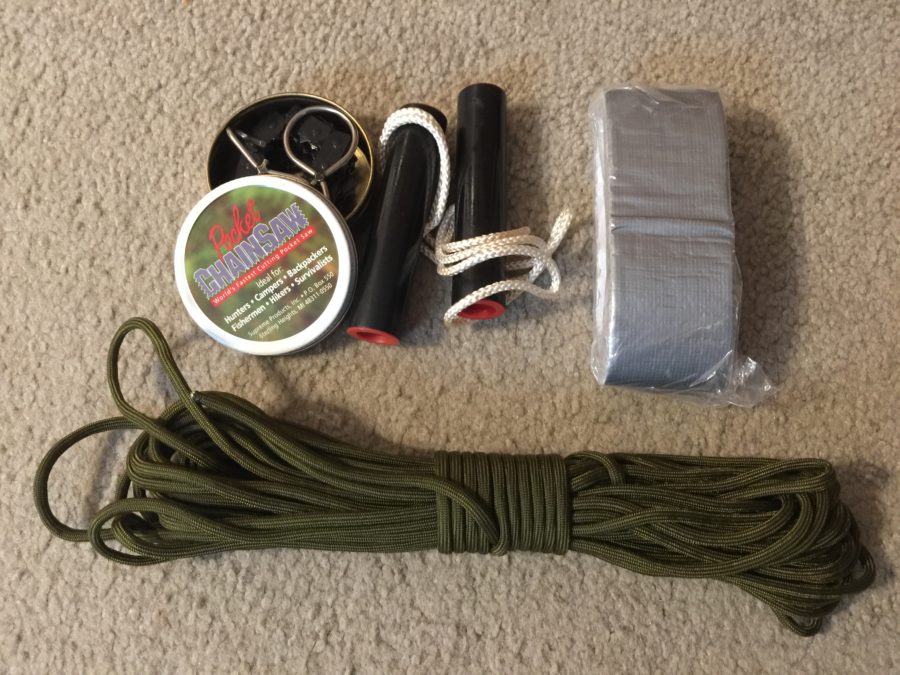
CHEM LIGHTS: Chem lights are great for emergency lighting and for signaling.
SIGNAL MIRROR: For emergency signaling.
WHISTLE: For emergency signaling
BINOCULARS: These allow you to extend your situational awareness far beyond what your naked eye isn’t capable of. Even a cheap pair of pocket 8x or 10x binoculars will help a lot.
GUERILLA TAPE: There are hundreds of uses for Guerilla Tape, everything from fixing a shoe to repairing a torn tarp or poncho.
ZIP TIES: These are small, lightweight and have many uses, also work great for repairing clothes and gear.
CAN OPENER: Even if you don’t plan on packing any canned food it won’t hurt to have a small can opener. If your multi-tool has one it may not be absolutely necessary.
CONTRACTOR BAG: Contractor bags have many uses like water collection, shelter, flotation device, etc.
Communication
Before, during and after disasters it’s important to keep informed and about what’s going on in your area and keeping in touch with your group or others. Many times during emergencies cell phone infrastructure is overloaded or inoperative, so having an alternate communication plan is a good idea. Having handheld two-way radios to get in touch with others in your group or to coordinate your bug out plans with others in your group
HAM RADIO: Amateur radios also know as Ham radios are the most capable radios available to the general public. Under normal circumstances, you need a license to transmit on a Ham radio but in emergencies, anyone can. You don’t need a license to own or listen to Ham frequencies. If the grid is down I would consider that to be an emergency. Most two way radios are restricted to line-of-sight communications but Ham’s can utilize repeaters. Repeaters are an antenna that can retransmit the signal, allowing for a much greater range.
FRS/GMRS: These are the typical walkie-talkies you can pick up at your local sporting goods store. FRS/GMRS have 22 channels, FRS has 7 dedicated channels, GMRS has 8 dedicated channels and they share 7. FRS or Family Radio Service is restricted to certain frequencies and has low power output and does not require a license. GMRS or General Mobile Radio Service, this does require a license from the FCC. GMRS operates on frequencies very close to the FRS radios but can transmit with a higher wattage. Most times those walkie-talkies have the ability to operate on both FRS and GMRS. These are strictly line-of-sight radios so transmitting ranges can vary a lot depending on what’s between the two radios.
CITIZENS BAND: Citizens Band or CB is another example of a line-of-sight, limited range radio. Mostly used by truckers these days, CB’s have 40 channels and does not require a license to operate.
Hygiene
Hygiene and general cleanliness are just as important during your bug out as it is in your daily life. Staying clean reduces the chances of getting sick or getting others sick.
- Toilet Paper
- Baby Wiper
- Hand Sanitizer
- Toothbrush and Toothpaste
- Soap
- Shampoo
- Wash Rag
- Small Towel
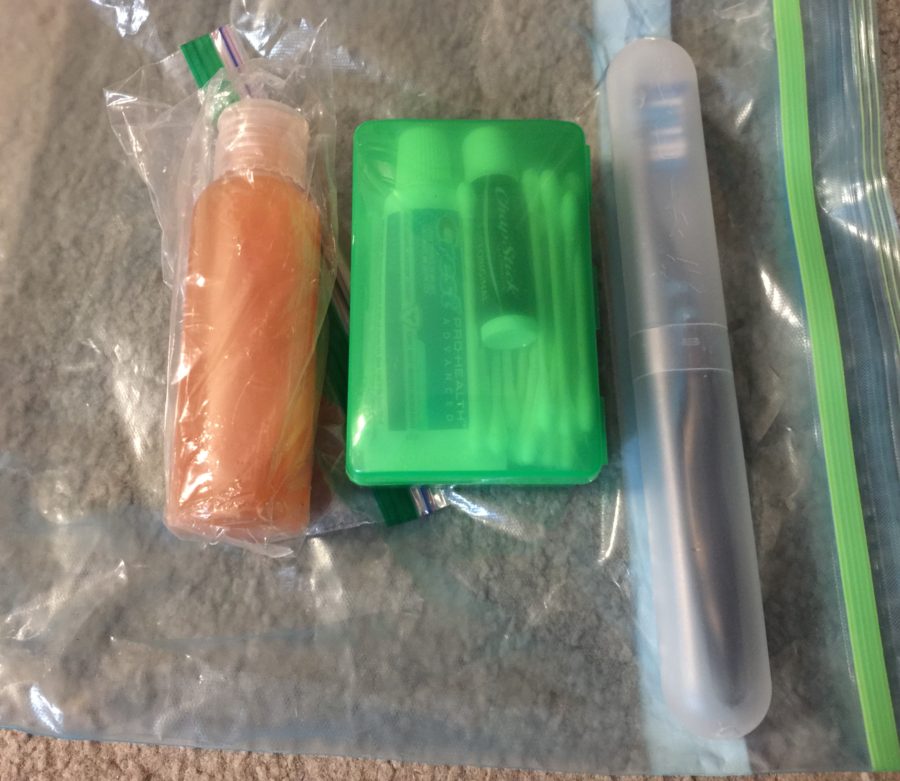
Personal Items
FAMILY OR GROUP PHOTO: This is something many don’t think about but if you or someone in your group gets separated it’s a good idea to have a photograph to aid in finding them.
CASH: Cash talks, and if the power grid is down you can forget about your credit card working and other electronic systems are down.
PRESCRIPTION MEDICATIONS: Make sure if you take medications that you have a backup supply in the event that you are unable to get refills.
THUMB DRIVE/HARD DRIVE: It’s a good idea to have copies of all your important documents. Have copies of your deeds, insurance policies, titles, investments, and more. If you have enough storage space you can have copies of all your family photos and videos too.
FEMININE PRODUCTS:
DIAPERS/PULL-UPS: Don’t forget about your younger children and their needs.
Vehicle Bug Out Kit
A Vehicle Bug Out Kit is a pre-staged collection of gear and supplies that are ready to easily load into your vehicle in the event that you need to bug out and you can take your vehicle. This kit will include more supplies like what’s in your Bug Out Bag, plus other things that are too large and/or heavy to be carried on foot.
- Extra Food and Water
- Tent
- Sleeping Bag
- Ground Pad
- Extra Clothing
- Camp Stove
- Mess Kit
- Long Guns and Ammo
- Extra Handgun Ammo
- Fishing Equipment
Final Thoughts
When it comes to choosing the items for your Bug Out Bag, don’t try to pack everything on the list into your bag. You need to take into consideration all the different factors related to your bug out plan and your unique situation. Keep in mind that this is not an all-encompassing list, you may have special needs that are unique to you or your family that will need to be addressed.

